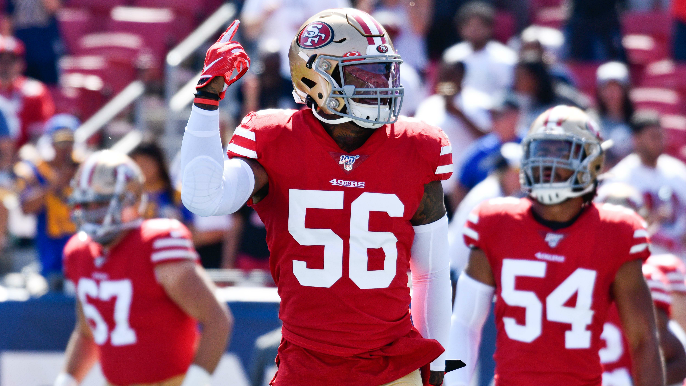© Robert Hanashiro-USA TODAY Sports
When Kwon Alexander tore his right pectoral muscle against the Arizona Cardinals on October 31, it was rightly viewed as the end of his season. Less than a week later, he underwent surgery and was placed on injured reserve, an all-but certain indication that his season was over. And it almost certainly still is.
But thanks to Kendrick Bourne, who is not a licensed medical professional, the winds of a potential Alexander return have started to swirl. He posted on his Instagram story a video of Alexander catching passes, and said Alexander told him that he would return this season.
Head coach Kyle Shanahan said Tuesday (in response to being asked about Bourne’s video and statement) that an Alexander return hasn’t been ruled out completely, but would be a “long shot.” That might be an understatement.
Kwon Alexander is back on the practice field doing side work.
Note on Kendrick Bourne’s IG story: “Kwon said he comin back this year” ? pic.twitter.com/yWJp3TwTJZ
— TheSFNiners (@TheSFNiners) December 16, 2019
As has been proven time and time and time again, players are not the best evaluators of their own health. Earlier this season, Ahkello Witherspoon only expected to rest over the Week 4 bye and return in Week 5. He instead missed eight games.
Richard Sherman may be an exception to that rule in that unless he’s lost a limb, he’ll probably play, but most players don’t fall into that category, and even Sherman would not be able to play through the same torn pectoral that Alexander suffered.
While Alexander was also seen catching passes in the portion of practice open to media on Wednesday, that might ultimately mean little in terms of where he’s at in recovery.
Dr. Bashir A. Zikria, MD, MSc, is Johns Hopkins University’s Director of Sports Medicine Arthroscopy Education and is an expert in dealing with tears of the pectoralis major, which is what happened to Alexander.
In a conversation with KNBR, Zikria said there are three main types of tears of the pectoral muscle, which is attached to a pair of heads: the sternal head (attached to the sternum) and the clavicular head (attached to the clavicle), both of which are attached to the humerus, the large arm bone which is next to the bicep.
The first, and most commonly seen type of tear, is where the muscle tears off the bone, usually off of the sternal head, in what’s called an “eccentric contraction.” The muscle is still attached at the other end to the humerus. This can happen often in bench presses as the barbell comes down, and is normally treated with surgery.
The second type of tear is at the musculotendinous junction, connecting muscle and tendon. The third type of tear is when the muscle itself tears (i.e. attached to both heads, but tears in the middle). These latter two are normally treated without surgery.
Because Alexander underwent surgery, it indicates he likely suffered the first type of tear and it likely tore off his sternal head. Zikria says that on average, the recovery time from this type of injury is nine months, with the absolute earliest being around the sixth-month mark. That would put Alexander’s earliest recovery in late April.
No NFL players who were placed on injured reserve with a pectoral injury returned later in the season in any of the past three years.
What makes this recovery so grueling?
“One, you’ve got to get the tendon to heal to bone, and then you’ve got to build that strength back up, to prevent re-injury,” Zikria said. “Essentially, what happens is that the muscle gives out and that’s when the tendon comes off. It depends on what sport you’re playing and if you’re playing a non-contact sport you can probably go back, maybe at six months, but football, on average, is about nine months.”
But what about Alexander catching passes? That’s completely normal, Zikria said. That type of movement isn’t putting massive strain on the muscle fibers that were torn. Those take about three months to heal before weight-lifting can be slowly reincorporated.
“At three, four months, you can probably start doing light lifting,” Zikria said. “Slowly work the muscles, so the muscle is not atrophying… Three months you’ve got a decent amount of biological healing. It’s not completely healing, but you’ve got a decent amount of biological healing. But as far as strength and everything else to prevent the injury and all that, you’re not close.”
The Super Bowl is scheduled for February 2, which would put Alexander just beyond the three-month mark, and just at the start of that period of being able to get his strength back through lifting While his season is almost certainly over, he is very likely to get back to full strength for next season, especially considering he had surgery within the first week of the injury.
“Success from surgery is very good,” Zikria said. “Above 90 percent return to strength and sport. And especially if you do fix it early on, within four weeks of the injury.”



